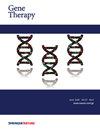Engineered AAV capsids mediate transduction of murine neurofibroma and sciatic nerve
IF 4.5
3区 医学
Q1 BIOCHEMISTRY & MOLECULAR BIOLOGY
引用次数: 0
Abstract
Genetic diseases such as Neurofibromatosis type 1 (NF1) and Charcot-Marie Tooth disease involve Schwann cells (SCs) associated with peripheral nerves. Gene therapy using adeno-associated virus (AAV) vector mediated gene delivery is a promising strategy to treat these diseases. However, AAV-mediated transduction of SCs in vivo after intravascular delivery is relatively inefficient, with a lack of extensive characterization of different capsids to date. Here, we performed an in vivo selection with an AAV9 capsid peptide display library in a mouse model of NF1. We chose one capsid variant, AAV-SC3, which was present in NF1 nerves for comparison to two benchmark capsids after systemic injection. AAV-SC3 significantly outperformed one of the two benchmark capsids at levels of transgene mRNA in the neurofibroma. Immunofluorescence microscopy revealed transgene expressing Sox10-positive SCs throughout the neurofibroma with AAV-SC3 injection. Next, we performed a pooled screen with four of the top capsids from our initial selection and AAV9 and identified one capsid, AAV-SC4, with enhanced biodistribution to and transduction of normal sciatic nerve in mice. This capsid displayed a peptide with a known laminin-binding motif, which may provide a conduit for future laminin-targeting strategies. Our results provide a baseline for future AAV-based gene therapies developed for NF1 or other diseases that affect SCs.

工程AAV衣壳介导小鼠神经纤维瘤和坐骨神经的转导。
遗传疾病如1型神经纤维瘤病(NF1)和Charcot-Marie牙病涉及与周围神经相关的雪旺细胞(SCs)。利用腺相关病毒(AAV)载体介导的基因传递进行基因治疗是治疗这些疾病的一种很有前途的策略。然而,血管内递送后,aav介导的sc在体内的转导相对低效,迄今为止缺乏对不同衣壳的广泛表征。在这里,我们在小鼠NF1模型中使用AAV9衣壳肽展示文库进行了体内选择。我们选择了一种衣壳变体AAV-SC3,它存在于NF1神经中,用于与全身注射后的两种基准衣壳进行比较。在神经纤维瘤中,AAV-SC3在转基因mRNA水平上显著优于两种基准衣壳之一。免疫荧光显微镜显示,注射AAV-SC3后,整个神经纤维瘤中表达sox10阳性的转基因SCs。接下来,我们对最初选择的四种顶级衣壳和AAV9进行了汇总筛选,并鉴定出一种衣壳,AAV-SC4,在小鼠正常坐骨神经的生物分布和转导中具有增强作用。该衣壳显示了一个具有已知层粘连蛋白结合基序的肽,这可能为未来的层粘连蛋白靶向策略提供了一个通道。我们的研究结果为未来针对NF1或其他影响SCs的疾病开发基于aav的基因疗法提供了基线。
本文章由计算机程序翻译,如有差异,请以英文原文为准。
求助全文
约1分钟内获得全文
求助全文
来源期刊

Gene Therapy
医学-生化与分子生物学
CiteScore
9.70
自引率
2.00%
发文量
67
审稿时长
4-8 weeks
期刊介绍:
Gene Therapy covers both the research and clinical applications of novel therapeutic techniques based on a genetic component. Over the last few decades, significant advances in technologies ranging from identifying novel genetic targets that cause disease through to clinical studies, which show therapeutic benefit, have elevated this multidisciplinary field to the forefront of modern medicine.
 求助内容:
求助内容: 应助结果提醒方式:
应助结果提醒方式:


